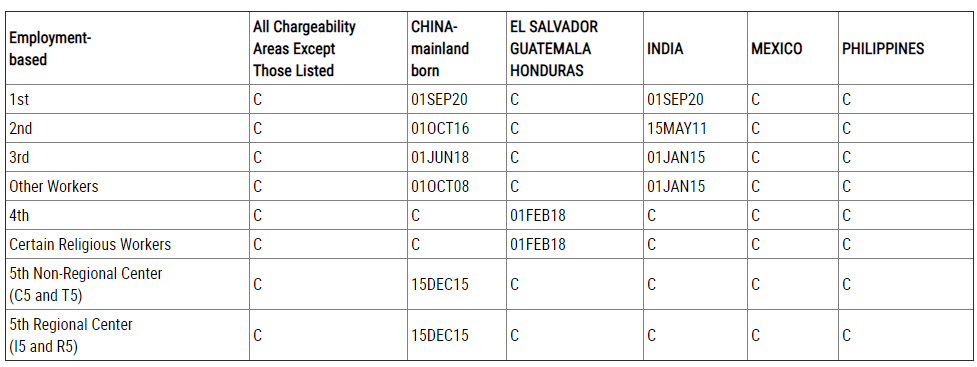
Posted September 24th, 2020 in Top Stories, Legal Insights with Tags Corporate Immigration, Immigration Law
How to Read The Visa Bulletin & What October’s Bulletin Means for Employment-Based Immigration
America’s immigration system is based on a quota system. This means that there is a limited number of permanent resident visas available each year, with limits per category and per country. This article will focus on the employment-based categories only.
How to Interpret the Visa Bulletin
The Visa Bulletin is updated monthly by the U.S. Department of State to notify stakeholders of the availability of permanent resident (immigrant) visas. In order to understand how to read the Visa Bulletin, it is helpful to know the following:
Priority Date
The Priority Date is the date on which the first step to permanent residence is filed. For most immigrant visa applicants, this would be the date that the labor certification application was filed. For positions that are exempt from labor certification, it’s the date that the Immigrant Petition for Alien Worker (I-140) petition is filed.
Categories
The Employment-Based categories are as follows:
- EB-1: Priority Workers (Aliens of Extraordinary Ability; International Managers/Executives; Outstanding Professors and Researchers)
- EB-2: Members of the Professions Holding Advanced Degree; Persons of Exceptional Ability
- EB-3: Professionals; Skilled Workers; Other Workers
- EB-4: Special Immigrants
- EB-5: Employment Creation Visas
Charts
There are two charts: Final Action Chart and Dates for Filing Chart:
Final Action Chart
Mandatory
This chart determines the actual availability of immigrant visas. This is not optional. A date on this chart means a person can apply for adjustment of status (if in the United States) or for an immigrant visa through the Consulate (if not in the United States) if their priority date is before that which is listed in the chart.
Dates for Filing Chart
Optional
This chart allows those within the United States to apply for permanent residence even though an immigrant visa is not yet available. Filing early allows each applicant to apply for work and travel authorization. This chart is optional, and the USCIS has the discretion whether or not to honor these dates.
A date on this chart means that a person can apply for adjustment of status if their priority date is before that which is listed in the chart. The permanent residence applications will be held in abeyance until an immigrant visa is available in the Final Action Chart, but the applications for interim benefits (work and travel authorization) will be adjudicated.
October’s Visa Bulletin
This year’s fiscal year reset was widely rumored to have a historical number of family-based visa numbers leftover from Fiscal Year 2020. This is important because all unused family-based visas get allocated to the next year’s employment-based numbers. What this means, specifically, is that for FY2021, instead of the usual 140,000 visas reserved for employment-based immigration, there will be 261,500 (almost double). The additional numbers will result in a dramatic decrease in visa wait times in the employment-based categories, particularly for Indian and Chinese nationals.
The USCIS announced on September 24, 2020, that it will honor the Dates for Filing Chart. That chart looks like this:

The Department of State is assessing the demand for the advancement of dates before it does so, taking into account the USCIS capacity to process applications.
The Nilan Johnson Lewis immigration team monitors the advancement of visa numbers each month to determine the availability for immigrant visas.
